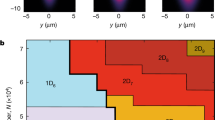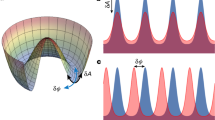Abstract
The concept of a supersolid state combines the crystallization of a many-body system with dissipationless flow of the atoms from which it is built. This quantum phase requires the breaking of two continuous symmetries: the phase invariance of a superfluid and the continuous translational invariance to form the crystal1,2. Despite having been proposed for helium almost 50 years ago3,4, experimental verification of supersolidity remains elusive5,6. A variant with only discrete translational symmetry breaking on a preimposed lattice structure—the ‘lattice supersolid’7—has been realized, based on self-organization of a Bose–Einstein condensate8,9. However, lattice supersolids do not feature the continuous ground-state degeneracy that characterizes the supersolid state as originally proposed. Here we report the realization of a supersolid with continuous translational symmetry breaking along one direction in a quantum gas. The continuous symmetry that is broken emerges from two discrete spatial symmetries by symmetrically coupling a Bose–Einstein condensate to the modes of two optical cavities. We establish the phase coherence of the supersolid and find a high ground-state degeneracy by measuring the crystal position over many realizations through the light fields that leak from the cavities. These light fields are also used to monitor the position fluctuations in real time. Our concept provides a route to creating and studying glassy many-body systems with controllably lifted ground-state degeneracies, such as supersolids in the presence of disorder.
This is a preview of subscription content, access via your institution
Access options
Access Nature and 54 other Nature Portfolio journals
Get Nature+, our best-value online-access subscription
$29.99 / 30 days
cancel any time
Subscribe to this journal
Receive 51 print issues and online access
$199.00 per year
only $3.90 per issue
Buy this article
- Purchase on Springer Link
- Instant access to full article PDF
Prices may be subject to local taxes which are calculated during checkout




Similar content being viewed by others
References
Boninsegni, M. & Prokof’ev, N. V. Supersolids: what and where are they? Rev. Mod. Phys. 84, 759–776 (2012)
Chan, M. H. W., Hallock, R. B. & Reatto, L. Overview on solid 4He and the issue of supersolidity. J. Low Temp. Phys. 172, 317–363 (2013)
Andreev, A. F. & Lifshitz, I. M. Quantum theory of defects in crystals. Sov. Phys. JETP 29, 1107–1113 (1969)
Thouless, D. J. The flow of a dense superfluid. Ann. Phys. 52, 403–427 (1969)
Kim, E. & Chan, M. H. W. Probable observation of a supersolid helium phase. Nature 427, 225–227 (2004)
Kim, D. Y. & Chan, M. H. W. Absence of supersolidity in solid helium in porous Vycor glass. Phys. Rev. Lett. 109, 155301 (2012)
Matsuda, H. & Tsuneto, T. Off-diagonal long-range order in solids. Prog. Theor. Phys. 46, 411–436 (1970)
Baumann, K., Guerlin, C., Brennecke, F. & Esslinger, T. Dicke quantum phase transition with a superfluid gas in an optical cavity. Nature 464, 1301–1306 (2010)
Mottl, R. et al. Roton-type mode softening in a quantum gas with cavity-mediated long-range interactions. Science 336, 1570–1573 (2012)
Bloch, I., Dalibard, J. & Zwerger, W. Many-body physics with ultracold gases. Rev. Mod. Phys. 80, 885–964 (2008)
Lahaye, T., Menotti, C., Santos, L., Lewenstein, M. & Pfau, T. The physics of dipolar bosonic quantum gases. Rep. Prog. Phys. 72, 126401 (2009)
Kadau, H. et al. Observing the Rosensweig instability of a quantum ferrofluid. Nature 530, 194–197 (2016)
Zeiher, J. et al. Many-body interferometry of a Rydberg-dressed spin lattice. Nat. Phys. 12, 1095–1099 (2016)
Moses, S. A. et al. Creation of a low-entropy quantum gas of polar molecules in an optical lattice. Science 350, 659–662 (2015)
Goldman, N., Juzeliūnas, G., Öhberg, P. & Spielman, I. B. Light-induced gauge fields for ultracold atoms. Rep. Prog. Phys. 77, 126401 (2014)
Li, J. et al. Spin-orbit coupling and spin textures in optical superlattices. Phys. Rev. Lett. 117, 185301 (2016)
Ostermann, S., Piazza, F. & Ritsch, H. Spontaneous crystallization of light and ultracold atoms. Phys. Rev. X 6, 021026 (2016)
Gopalakrishnan, S., Lev, B. L. & Goldbart, P. M. Emergent crystallinity and frustration with Bose–Einstein condensates in multimode cavities. Nat. Phys. 5, 845–850 (2009)
Labeyrie, G. et al. Optomechanical self-structuring in a cold atomic gas. Nat. Photon. 8, 321–325 (2014)
Kollár, A. J. et al. Supermode-density-wave-polariton condensation. Preprint at https://arxiv.org/abs/1606.04127 (2016)
Lemoine, M., Martin, J. & Peter, P. (eds) Inflationary Cosmology Ch. 11 (Springer, 2008)
Eichhorn, A., Mesterházy, D. & Scherer, M. M. Multicritical behavior in models with two competing order parameters. Phys. Rev. E 88, 042141 (2013)
Ritsch, H., Domokos, P., Brennecke, F. & Esslinger, T. Cold atoms in cavity-generated dynamical optical potentials. Rev. Mod. Phys. 85, 553–601 (2013)
Asbóth, J. K., Domokos, P. & Ritsch, H. Correlated motion of two atoms trapped in a single-mode cavity field. Phys. Rev. A 70, 013414 (2004)
Safaei, S., Miniatura, C. & Grémaud, B. Triangular and honeycomb lattices of cold atoms in optical cavities. Phys. Rev. A 92, 043810 (2015)
Nagy, D., Szirmai, G. & Domokos, P. Critical exponent of a quantum-noise-driven phase transition: the open-system Dicke model. Phys. Rev. A 84, 043637 (2011)
Brennecke, F. et al. Real-time observation of fluctuations at the driven-dissipative Dicke phase transition. Proc. Natl Acad. Sci. USA 110, 11763–11767 (2013)
Strack, P. & Sachdev, S. Dicke quantum spin glass of atoms and photons. Phys. Rev. Lett. 107, 277202 (2011)
Fan, J. et al. Hidden continuous symmetry and Nambu-Goldstone mode in a two-mode Dicke model. Phys. Rev. A 89, 023812 (2014)
Baksic, A. & Ciuti, C. Controlling discrete and continuous symmetries in “superradiant” phase transitions with circuit QED systems. Phys. Rev. Lett. 112, 173601 (2014)
Léonard, J. et al. Optical transport of ultracold atoms using focus-tunable lenses. New J. Phys. 16, 093028 (2014)
Emary, C. & Brandes, T. Chaos and the quantum phase transition in the Dicke model. Phys. Rev. E 67, 066203 (2003)
Hayn, M., Emary, C. & Brandes, T. Phase transitions and dark-state physics in two-color superradiance. Phys. Rev. A 84, 053856 (2011)
Acknowledgements
We thank E. Demler, J. Larson and B. P. Venkatesh for discussions on U(1) symmetries in optical cavities and M. Lee for contributions in the building stage of the experimental apparatus. We acknowledge funding from Synthetic Quantum Many-Body Systems (European Research Council advanced grant) and the EU Collaborative Project TherMiQ (Grant Agreement 618074), and also SBFI support for Horizon2020 project QUIC and SNF support for NCCR QSIT and DACH project ‘Quantum Crystals of Matter and Light’.
Author information
Authors and Affiliations
Contributions
All authors contributed extensively to the work presented here.
Corresponding author
Ethics declarations
Competing interests
The authors declare no competing financial interests.
Additional information
Reviewer Information Nature thanks K. Hazzard and D. Huse for their contribution to the peer review of this work.
Extended data figures and tables
Extended Data Figure 1 Mean-field solution of the phase diagram.
Order parameters α1 and α2 as a function of the pump–cavity detunings Δ1 and Δ2. The Raman coupling λ is fixed by the experimental value of the transverse pump lattice depth of 38ħωrec. The mean-field model includes cavity decay, different vacuum Rabi frequencies gi and the transverse pump potential.
Extended Data Figure 2 Lattice geometries for different choices of the phase ϕ of the transverse pump field for balanced cavity fields.
The atoms are cut into one-dimensional lines by the strong transverse pump field. On top, spatial distributions between triangular (ϕ = 0) and hexagonal (ϕ = π/2) can form through the interference between the cavity light fields and the transverse pump, depending on the phase ϕ of the latter.
Extended Data Figure 3 Dependence of the lattice structure on the cavity field amplitudes.
The ground-state manifold for equal couplings and detunings in  is a circle in the space of the cavity fields α1 and α2. For each combination of fields, the interference potential in equation (3) between the transverse pump and cavity fields for ϕ = π/2 will have its minima at different positions. Following the circle clockwise, every second line moves left (top highlighted line) while the others move right (bottom highlighted line).
is a circle in the space of the cavity fields α1 and α2. For each combination of fields, the interference potential in equation (3) between the transverse pump and cavity fields for ϕ = π/2 will have its minima at different positions. Following the circle clockwise, every second line moves left (top highlighted line) while the others move right (bottom highlighted line).
Extended Data Figure 4 Transition between discrete and continuous symmetries.
a–c, Histograms (normalized to unity area) of the angles θ describing the position of the crystal lattice, measured in the same way as the data in Fig. 4, but at Δ1 = −2.1 MHz (a), Δ1 = −2.2 MHz (b) and Δ1 = −2.3 MHz (c). The grey lines show kernel density estimation analyses with a Gaussian kernel, whose bandwidth of 0.13π/2 was determined from a cross-validation maximum likelihood reconstruction. Each histogram consists of 19–49 realizations.
Rights and permissions
About this article
Cite this article
Léonard, J., Morales, A., Zupancic, P. et al. Supersolid formation in a quantum gas breaking a continuous translational symmetry. Nature 543, 87–90 (2017). https://doi.org/10.1038/nature21067
Received:
Accepted:
Published:
Issue Date:
DOI: https://doi.org/10.1038/nature21067
This article is cited by
-
Giant magnetocaloric effect in spin supersolid candidate Na2BaCo(PO4)2
Nature (2024)
-
Sudden change of the photon output field marks phase transitions in the quantum Rabi model
Communications Physics (2024)
-
Experimental observation of spontaneous symmetry breaking in a quantum phase transition
Science China Physics, Mechanics & Astronomy (2024)
-
Density-wave ordering in a unitary Fermi gas with photon-mediated interactions
Nature (2023)
-
Heating a dipolar quantum fluid into a solid
Nature Communications (2023)
Comments
By submitting a comment you agree to abide by our Terms and Community Guidelines. If you find something abusive or that does not comply with our terms or guidelines please flag it as inappropriate.



